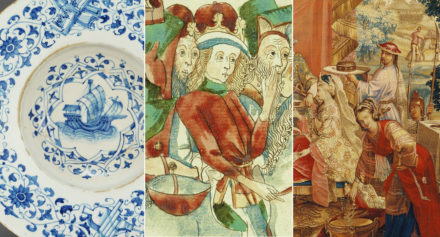Update—We’ve posted video excerpts from Patrick McGovern’s talk. See below for his discussion of Midas Touch, here for Chateau Jiahu, and here for Theobroma.
What ancient brews were served at the funeral feast of King Midas, or his father Gordius, around 700 B.C? Which delicious elixirs were Socrates and his pupil Plato likely imbibing as they wrestled over ethics at those famous drinking parties in ancient Greece?
Patrick McGovern knows part of the answer. An archaeologist and chemist who may have the world’s coolest job—scientific director of the Biomolecular Archaeology Laboratory for Cuisine, Fermented Beverages, and Health at the University of Pennsylvania Museum—he’s giving two talks, followed by brew tastings, this weekend at the Getty Villa.

Patrick McGovern in his lab, sniffing out an ancient brew
Patrick, who is something of a forensic mixologist, follows chemical clues and uses advanced processes to analyze ancient organic compounds and identify recipes. So far, bioarchaeologists have discovered the rice wines of ancient China, and Japan, barley beer and grape wine from the Middle East, corn beers of the Americas, and the elite cacao or chocolate fruit drink of the New World.
Cocktails aside, alcohol has also been used for medicinal purposes, religious ceremonies, and artistic inspiration for as far back as 7,000 B.C. Greek philosophy grew out of the famous symposia of ancient Greece, where men celebrated athletic feats and read poetry as their cups overflowed with wine.
“These are liquid time capsules,” Patrick told me of the ancient brews he researches. “You really feel transported back into the past when you do this.” Uncovering the story of the funeral feast of King Midas must have been like stumbling into a great party 2,700 years late. At the royal burial site in central Turkey, the remains of the feast included a treasure trove of Iron Age drinking vessels.
Patrick and his fellow archeologists extracted the organic compounds from the pottery and used sophisticated bimolecular techniques to tease out the natural ingredients. The recipe for the drink? Barley beer, honey mead, and grape wine. Once this essential formula was identified, a slew of microbrewers stepped forward to
re-engineer the ancient concoction and add a dash of spice (since hops came much later in Europe). Dogfish Head’s Midas Touch—part of whose trick was adding saffron—won the gold medal. Fittingly, as King Midas was famous in Greek mythology for wishing that everything he touched turned to gold. (As this drawing of the Judgment of Midas shows, the king later regretted his wish).
Despite his enthusiasm for cooking up ancient brews, Patrick advises against making these “extreme beverages” at home without special equipment. It’s not easy, and as you’re producing carbon dioxide, things might…blow up.
Maybe a better—and equally time-honored—tribute to the god Dionysus would be to wear a wreath of grape leaves on your head. After drinking a Midas Touch, of course.




Finally… some meaningful archaeological research! I say we all hook up with Professor McGovern and toss back a couple of Apollo Wallbangers and Satyr Slings.
After which I promise to reenact a menage a trois with Aphrodite, Eros and myself followed by a Herculean hangover!
Looking forward to seeing the video and keep up the good work.
This sounds like a lot of fun. I’d be willing to throw back some mead with Odin, or party it down with Bacchus.
I am a Middle School student and this is very informational. I am doing a Classroom Based Assessment (CBA) on food, drinks, and desserts in Ancient Rome and Ancient Greece.